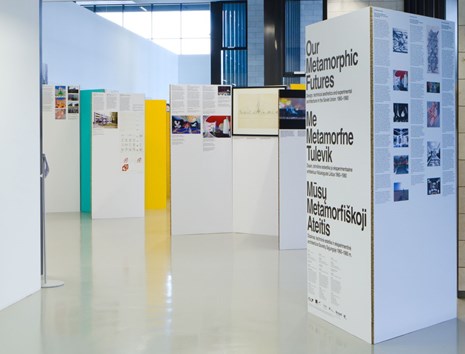Our Metamorphic Futures

Our Metamorphic Futures
Design, Technical Aesthetics and experimental
architecture in Soviet Union 1960-1980
Soviet environment is usually represented as uniform and boring. Soviet architecture is associated with monotonous mass housing and design with ugly objects. Yet, throughout the decades of the 1960s and 1970s there emerged a series of progressive projects that saw the production of a new ideal living environment as its aim. This was to be an environment easily changable and adaptable to the user's needs, relying on newest technological accomplishments and rethinking through this also the human being as its part.
Architectural group "NER" from Moscow imagined linear cities of the future, where an easily reproducible unit of settlement would solve the problem of overpopulation and where new technology steps into the service of the user, among other things, though architecture that can be transformed over time. Vyacheslav Koleichuk investigated from late 1960s onwards the use of so called self-building structures, that are assembled in factories but would be unfolded only in the place of use, either in the building site or even in outer space. Similar structures were used by Lithuanian architect Eugenijus Miliūnas in a project for a dwelling erected in short time. Vyacheslav Loktev and Lev Nussberg both devised space conquering futures cities, meant to become a basis for an harmonious global system of settlement.
These projects are following a belief, that new technology will be the basis for transforming society and that through design of the environment and new spatial models it would be possible to solve social problems. This meant also an extension of design and architectural practice, shifting - in synchrony with international design thought - from the design of singular objects to the organisation of an environment (and life practice) as a whole.
The group "Dvizhenie" from Moscow worked since the early 1960s in an interdisciplinary territory between design, urban planning, art and architecture, devising projects ranging from simple urban decoration to complex artificial environments. In their work, as well as in the objects by Jānis Krievs, Valdis Celms or Kaarel Kurismaa, produced for urban environment, grey and banal Soviet environment was replaced with a surprising and unexpected one.
Soviet design discourse that emerged in the 1960s, alongside new institutions like VNIITE - an all-soviet research institute of technical aesthetics - and experimental design studio "Senezh", were likewise coming up with projects for the new environment. In the 1970s artists Leonhard Lapin and Sirje Runge in Tallinn and Māris Ārgalis and Artūrs Riņķis in Riga, intervened actively in urban decoration. Their all-embracing spatial projects were meant to overcome the monotony of modernist cities as well as the bureaucratic way of life, offering a social space that allows involvement but is also entertaining and seductive. User participation was rethought in several design exhibitions, like the ones designed by Jurgis Vroblevičius in Vilnius or a series of exhibtions "Space and Form" in Tallinn.
In mid-1970s the relationship to design as well as technology becomes more ambivalent. The congress of international council of industrial design ICSID, taking place in Moscow in October 1975 under the title "Design for man and society", privileged instead of autonomous design the notion of social design, drawing attention to the consumer's needs and critical design practice.
Sustainable and mobile cardboard furniture buildt for the congress spaces (designed by Alexandr Ermolaev) was inspired by ideas of anti-design and ecological thinking. With its help, a temporary and independent interior was built inside the hotel lobby producing an adjustable and adaptable space. Yuri Sobolev's and Yuri Reshetnikov's multimedia program, composed of slide screens and films and meant as an introduction to the congress, analysed critically the influence of technology and consumption. This project, taking a long time to prepare, was cancelled a few days before the congress and will be here brought to public for the first time.
Vitaly Komar's and Alexander Melamid's series of superobjects, presented bizarre consumer products mocking thus the role of design and its social ambition. Tiit Kaljundi's project for reconstructing the environment, from 1976, attempts to remedy the landscape that has been exhausted by modernisation. The experience of medialised space was investigated at that period by Andrei Monastysrki ("Collective Actions") and Jüri Okas.
These latter projects, produced outside state-financed research institutes and centres, take the viewer from outer space to the deserted wastelands or fields, signifying a need to think about the contradictions inherent in modernist ideals and culture designed by technology and industry, to think about the limits of growth.
Curators: Andres Kurg ir Mari Laanemets
(Tallinn)
Design: Indrek Sirkel (Tallinn), Kooperative
für Darstellungspolitik (Berlin)
The exhibition "Modernization. Baltic Art, Architecture, and
Design. 1960s-70s" is the part of the project "Recapturing the
Invisible Past" and was partly supported by the EU "Culture
2007-2013" program.
General sponsor: insurance company
BTA
Sponsors: Estijos kultūros fondas, Estijos
dailės akademija, JCDecaux, Servier Pharma,
Gedeon Richter, Re-board,
Media support: Lietuvos nacionalinis radijas ir televizija, Vilniaus diena


